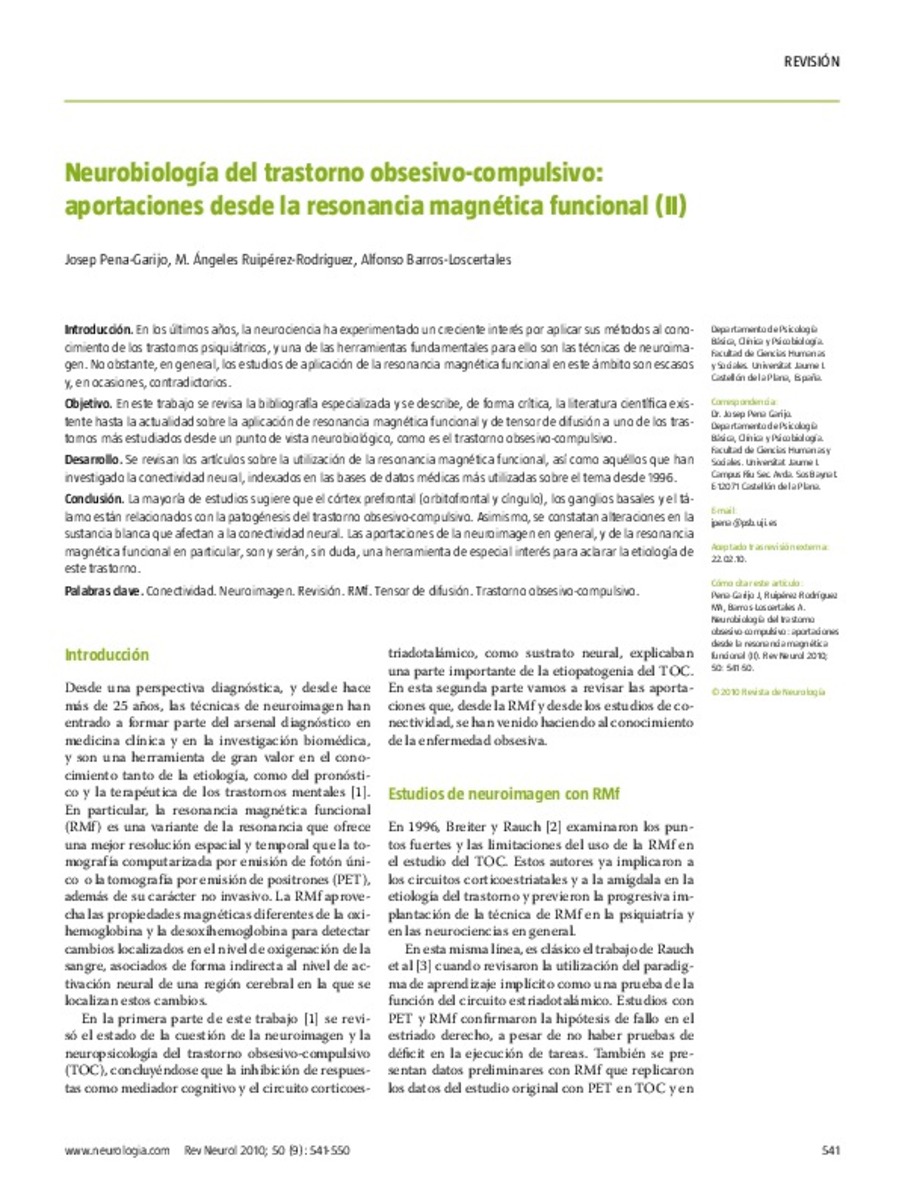Mostra el registre parcial de l'element
Neurobiología del trastorno obsesivo-compulsivo: aportaciones desde la resonancia magnética funcional (II)
| dc.contributor.author | Pena-Garijo, Josep | |
| dc.contributor.author | Ruipérez Rodríguez, María Ángeles | |
| dc.contributor.author | Barrós-Loscertales, Alfonso | |
| dc.date.accessioned | 2011-11-09T09:11:05Z | |
| dc.date.available | 2011-11-09T09:11:05Z | |
| dc.date.issued | 2010-05-01 | |
| dc.identifier.issn | 0210-0010 | |
| dc.identifier.other | PMID: 20443173 | |
| dc.identifier.uri | http://hdl.handle.net/10234/28726 | |
| dc.description.abstract | Introduction: in recent years, neuroscience has shown a growing interest in applying its methods to furthering the knowledge of psychiatric disorders, and one of the fundamental tools used to do so are neuroimaging techniques. Yet, in general, few studies have been conducted in which functional magnetic resonance has been applied in this field and findings are sometimes contradictory. Aims: in this study we review the specialised bibliography and present a critical discussion on the scientific literature published to date on the application of functional magnetic resonance and diffusion tensor imaging to one of the most widely studied disorders, from a neurobiological point of view, namely, obsessive-compulsive disorder. Development: the study reviews the articles on the use of functional magnetic resonance imaging, as well as those dealing with neural connectivity, that have been indexed in the most commonly used medical databases on the topic since 1996. Conclusions: most studies suggest that the prefrontal cortex (orbitofrontal and cingulate), the basal ganglia and the thalamus are involved in the pathogenesis of obsessive-compulsive disorder. Likewise, alterations in the white matter that affect neural connectivity have also been found. The contributions made by neuroimaging and, more specifically, by functional magnetic resonance imaging are and will undoubtedly continue to be a particularly interesting tool for explaining the aetiology of this disorder | |
| dc.description.abstract | Introducción. En los últimos años, la neurociencia ha experimentado un creciente interés por aplicar sus métodos al conocimiento de los trastornos psiquiátricos, y una de las herramientas fundamentales para ello son las técnicas de neuroimagen. No obstante, en general, los estudios de aplicación de la resonancia magnética funcional en este ámbito son escasos y, en ocasiones, contradictorios. Objetivo. En este trabajo se revisa la bibliografía especializada y se describe, de forma crítica, la literatura científica existente hasta la actualidad sobre la aplicación de resonancia magnética funcional y de tensor de difusión a uno de los trastornos más estudiados desde un punto de vista neurobiológico, como es el trastorno obsesivo-compulsivo. Desarrollo. Se revisan los artículos sobre la utilización de la resonancia magnética funcional, así como aquéllos que han investigado la conectividad neural, indexados en las bases de datos médicas más utilizadas sobre el tema desde 1996. Conclusión. La mayoría de estudios sugiere que el córtex prefrontal (orbitofrontal y cíngulo), los ganglios basales y el tálamo están relacionados con la patogénesis del trastorno obsesivo-compulsivo. Asimismo, se constatan alteraciones en la sustancia blanca que afectan a la conectividad neural. Las aportaciones de la neuroimagen en general, y de la resonancia magnética funcional en particular, son y serán, sin duda, una herramienta de especial interés para aclarar la etiología de este trastorno | |
| dc.format.extent | 10 p. | |
| dc.language.iso | spa | |
| dc.publisher | Viguera | |
| dc.relation.isPartOf | Revista de neurología, vol. 50, no. 9 (1/15 mayo, 2010), pp. 541-550 | |
| dc.rights | © Viguera | |
| dc.rights.uri | http://rightsstatements.org/vocab/InC/1.0/ | * |
| dc.subject | Connectivity | |
| dc.subject | Neuroimaging | |
| dc.subject | Diffusion tensor | |
| dc.subject | FMRI | |
| dc.subject | Obsessive-compulsive disorder | |
| dc.subject | Review | |
| dc.subject | Conectividad | |
| dc.subject | Neuroimagen | |
| dc.subject | Revisión | |
| dc.subject | RMf | |
| dc.subject | Tensor de difusión | |
| dc.subject | Trastorno obsesivo-compulsivo | |
| dc.subject.lcsh | Obsessive-compulsive disorder | |
| dc.subject.lcsh | Magnetic resonance | |
| dc.subject.other | Neurosi obsessiva | |
| dc.subject.other | Ressonància magnètica | |
| dc.title | Neurobiología del trastorno obsesivo-compulsivo: aportaciones desde la resonancia magnética funcional (II) | |
| dc.title.alternative | The neurobiology of obsessive-compulsive disorder: new findings from functional magnetic resonance imaging (II) | |
| dc.type | info:eu-repo/semantics/article | |
| dc.identifier.doi | https://doi.org/10.33588/rn.5009.2010154 | |
| dc.rights.accessRights | info:eu-repo/semantics/openAccess | |
| dc.type.version | info:eu-repo/semantics/publishedVersion |
Fitxers en aquest element
Aquest element apareix en la col·lecció o col·leccions següent(s)
-
PSB_Articles [1310]
Articles de publicacions periòdiques







